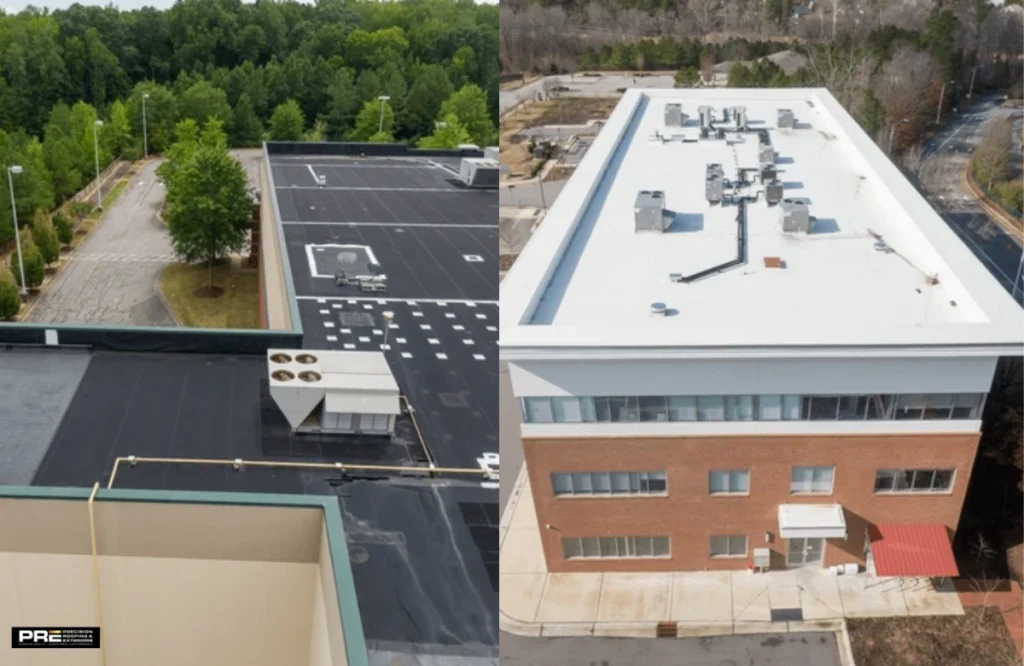Choosing the right roof for your building is an important decision. Two of the most common flat roofing options are TPO and EPDM. Both are durable and affordable, but they differ in performance and lifespan. TPO is a white, reflective membrane that lowers cooling costs and gives a modern look, while EPDM is a black rubber membrane known for its flexibility, long life, and lower cost. TPO usually lasts 15–25 years, while EPDM can last 20–30 years.
What Is the Difference Between TPO and EPDM?
Here are the most common differences:
What Is TPO Roofing?
TPO (Thermoplastic Polyolefin) is a blend of polymers, typically including ethylene-propylene rubber and polypropylene. It comes in white, gray, or tan and reflects sunlight well. This makes TPO energy-efficient, helping to lower cooling costs in the summer. It is resistant to dirt, mold, and punctures, which makes it a strong choice for commercial buildings. TPO roofing is easy to install and can be welded at the seams for extra durability.
What Is EPDM Roofing?
EPDM (Ethylene Propylene Diene Monomer) is a synthetic rubber roofing membrane. It is usually black, though white versions are also available. EPDM roofing is known for its flexibility and ability to handle extreme weather, including hot summers and freezing winters. It has been used for decades and is proven to last 20–30 years with proper maintenance. EPDM is a popular roof installation option for those who want a reliable, long-lasting roof at a lower upfront cost.
TPO vs. EPDM: Comparison Table
While both roofing systems protect your building, they differ in several important ways. Here’s a clear comparison:
| Feature | TPO Roofing | EPDM Roofing |
| Material | Thermoplastic blend of rubber and fillers | Synthetic rubber (black or white) |
| Energy Efficiency | Highly reflective, lowers cooling costs | Absorbs heat (black) but available in white |
| Durability | Resistant to punctures, dirt, and mold | Excellent in extreme weather, flexible |
| Lifespan | 15–25 years with care | 20–30 years with care |
| Cost | Moderate, slightly higher than EPDM | Budget-friendly, often cheaper |
| Look | White/bright colors for a modern appearance | Black or white, simple look |
| Best For | Energy savings and modern commercial buildings | Long-lasting, budget-conscious projects |
TPO vs. EPDM: Maintenance and Performance Comparison
TPO and EPDM can protect your building for many years, but their upkeep and performance differ in important ways. The table below shows how they compare:
| Aspect | TPO Roofing | EPDM Roofing |
| Maintenance Needs | Regular seam inspection is needed, as well as an easy-to-clean white surface. | Requires patching for punctures; adhesive seams may weaken. |
| Climate Suitability | Performs best in hot, sunny climates due to reflectivity. | Excellent in cold or variable climates thanks to flexibility. |
| Eco-Friendliness | Reflective and recyclable, it reduces cooling costs. | Long lifespan reduces waste, but absorbs more heat. |
| Repairs | Repairs often require professional tools for welding. | Easy patch repairs can be done with simple kits. |
| Energy Efficiency | Reflective surface lowers cooling bills. | Black surface absorbs heat; a white option is available but less common. |
EPDM vs. TPO: Which Roofing Should You Choose?
The best roofing option depends on your building needs and budget. TPO is a great choice for lower energy bills, a modern look, and protection against dirt and mold. EPDM is better if you want a proven, cost-effective system that lasts decades. Both are strong options, but the best choice depends on whether you prioritize energy efficiency, longevity, or affordability.
Pros and Cons of TPO Roofing
TPO is a popular choice for many modern buildings, but like any roofing material, it has strengths and weaknesses.
Pros:
- Reflective surface reduces cooling costs in summer.
- Modern look with white and light color options.
- Resistant to dirt, mold, and punctures.
- Seams can be heat-welded for extra strength.
Cons:
- Lifespan (15–25 years) is shorter than that of EPDM.
- It can shrink or crack if not installed properly.
- Slightly more expensive than EPDM.
- As a newer product, its long-term performance data is more limited compared to EPDM.
Pros and Cons of EPDM Roofing
EPDM has been used for decades and is known for its durability, but it has some drawbacks.
Pros:
- Proven track record with 20–30 years of use.
- Flexible in hot and cold weather.
- Very cost-effective compared to other flat roofing options.
- Easy to repair with patches when damage occurs.
Cons:
- Black surface absorbs heat, raising indoor temperatures.
- Less visually modern compared to TPO.
- More prone to punctures from sharp objects.
- Seams rely on adhesives or tape, which may weaken over time.
Conclusion
When comparing TPO vs. EPDM, both roofing types offer excellent protection for flat roofs. TPO offers energy efficiency and a modern look, while EPDM is reliable, budget-friendly, and long-lasting. The right choice depends on your building’s needs and budget.
If you’re ready to install or replace your roof, contact Precision Roofing today for expert roofing installation services and the right solution for your building.

